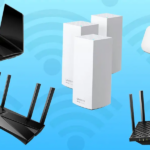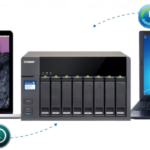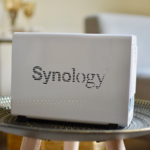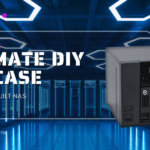In this article, we’ll explore the best NAS for photographers, starting with the most affordable option and moving to the finest picture NAS available for professional business use.
Many users learn about NAS drives for the first time when the constraints of their third-party cloud storage space (from companies like Google, Apple, or DropBox) become apparent, with few groups feeling the pinch more than avid amateur or professional photographers.
Backing up your photo collections to a free or low-cost subscription cloud space looks so easy! Backing up those images from your phone is so simple, and the space you can free up from your phone regularly is so handy – but after a year or two, it becomes clear that you have dug quite a hole!
Limitations include tiny storage capacity, slow backup rates, recurring payments for something you will have to pay for endlessly without genuine ownership, and the ever-present nagging question of whether your images are completely under your control. Many users who desire to leave the cloud will eventually require a place to store their images, and the collection will get larger as time passes.
Now, a NAS drive is much more than a simple “hard drive on the internet,” but rather a multi-faceted storage system that can serve as an easy photo backup device, a smart AI-powered photo recognition and organization tool, an editing target, a professional sharing space for business, or all of those things at once (along with a wide range of other services).
With the added advantage that YOU have FULL CONTROL over your photos, a NAS can offer an equivalent or greater level of photo data management than any cloud platform available today since it has evolved to keep up with advancements in camera technology. Today, I want to discuss the top three NAS drives available for photographers, starting with the most affordable option and moving to the finest picture NAS available for professional business use.
What’s Common to All the Best NAS for Photographers?
It’s important to remember that while many types of photography NAS drives are available for purchase, they are not all made equal! It might be alluring to think about super-budget companies in addition to premium NAS brands, especially with so many of them emerging online. Sadly, they frequently provide solutions that are “too good to be true,” disappear from the internet before your warranty expires, and all for nothing!
Therefore, the best NAS system ALWAYS includes the following software and services, regardless of whether you are looking at the three best photography solutions that I have listed below OR you are looking at another photography NAS that you saw offered or recommended elsewhere.
Combined Hardware & Software Solution:
This refers to a package that contains desktop client apps, mobile apps, web browser GUI, backup, media, streaming, surveillance, and file management software in addition to the hardware itself. The NAS systems in this book can be accessed and used with Windows, Mac, Android, and Linux operating systems. Every NAS solution has a two to three-year warranty, which can be extended to five years. Any NAS drive can be accessed locally across the network, and brand-supported services enable secure remote access (at no additional cost). Modern and frequently updated NAS systems can accommodate the newest 20TB NAS hard drives, like the WD Red 22TB and Seagate Ironwolf 22TB.
To protect against drive failure and enhance performance, all suggested systems enable multiple drive configurations (RAID). Regular upgrades are made to all systems’ security, functionality, and services. Every suggested NAS drive is compatible with cloud services (such as Google Drive, Dropbox, OneDrive, and others) and business/enterprise services (such AWS, Azure, Backblaze, and others).
The ability to host a shared drive on your PC, mobile device, or laptop that is synchronized with the NAS over the network or internet is a feature shared by all NAS solutions, regardless of brand (i.e. Mac Finder or Windows Explorer) For faster speeds of up to 100MB/s, you can connect an Ethernet or network cable from your PC or Mac computer directly to the NAS RJ45 socket to access any of the mentioned NAS systems. Regardless of brand, all the top NAS solutions come with backup and sync software that you can install on your local client PC to enable frequent backups of your files and system data.
Because these are some of the most prominent areas where brands all too frequently cut orders to build cheaper, ultimately inferior NAS servers for home and business, be sure that if you are looking at a NAS solution that is not recommended below, it includes everything mentioned above. Now, let’s talk about the top Photography NAS available in 2024.
Synology DS923+ NAS
32GB DDR4 ECC Memory, 4x 1Gbe Port, 10GbE Optional Upgrade Slot, 0-88TB, 4-Bays, 2x PCIe Gen 3 M.2 NVMe 2280, Dual Core AMD Emb. Ryzen R1600 CPU, 3-5 Year Warranty
Synology Photos (AI Photo Recognition), Synology Drive, Active Backup Suite, Hyper Backup, and 10GbE Support for Editing are some of the apps and tools for photographers and photo-sharing services. Synology took a chance when the Synology DS923+ NAS was released. The AMD Emb will inevitably be chosen over the Intel Celeron, which has previously been this product family’s construction choice. Ryzen has caused some agitation!
On the surface, the R1600 has many more advantages than the model that came before it! Increased clock speed, improved PCIe Gen 3 Support across the board, 4-32GB of DDR4 RAM in such a small form factor, and all-around more power to work with, along with improved bandwidth possibilities inside and out! But at what price? The base model’s 1GbE standard connectivity is somewhat lacking, and while very useful, the proprietary 10GB upgrade somewhat restricts upgradability.
The absence of an integrated graphics processor will probably cause many ardent Synology supporters to pass on this version. The Synology Diskstation Manager (DSM 7.1 at the time of writing) is still impressive. Despite the brand’s continued emphasis on first-party priorities, there is a little more leeway regarding media compatibility with Synology DSM 7.1 than with DSM 7 before.
I can’t criticize Synology’s design because the DS923+ chassis is still among the most attractive and remarkably well-organized gadgets at this size and storage capacity. As usual, the DS923+ excels in the software department, and DSM 7.2 is on the horizon to further improve things. A Synology NAS is more about the software than the hardware. Remember that the Synology DS923+ NAS has a system that emphasizes doing many things “their way.” More technically savvy administrators may find it difficult to employ this degree of user-friendly design and support, but less technically savvy users will undoubtedly like it! While the DS923+ is still a solid NAS drive, it is now more geared towards business users than homeowners this iteration.
QNAP TS-453E NAS
8GB fixed memory, 2x 2.5Gbe ports, 1 HDMI 1.4b 4K 30FPS, 0-88TB, 4-bays, 2x PCIe Gen 3×2 M.2 NVMe 2280, Intel Celeron J6412 CPU, and a 3-to 5-year warranty
QNAP Photo Station, QNAP QuMagie AI Photo Recognition, Multimedia Console Manager, QSync Share, HybridMount, Hybrid Backup Sync 3, and support for 2.5GbE and 5GbE Adapters are apps/tools for photographers and photo-sharing services.
I’ve come to like the QNAP TS-453E NAS! It is simple to observe that these home/business server firms fall into repetitious patterns when selecting hardware at each tier/price since they provide refreshes of their ranges approximately every two to three years. However, the TS-453E NAS managed to carve out a new tier into the brand’s portfolio for 2022. It gives you some perfect internal and external hardware that, given the level of QNAP’s 4-bay portfolio, most would have assumed would be half of what it is (i.e., Quad-Core, 8GB, NVMe M.2s, 2.5GbE, 10G USB, 3yr warranty, etc.). This will undoubtedly cause some buyers to question if the Prosumer/flagship TS-464 is still necessary.
Even with the 8GB default memory, the fixed memory is a bit unpleasant, and the lack of a PCIe slot means that 10GbE won’t be possible. However, when you see this NAS positioned between the TS-451D2 and TS-464, it all makes sense. This is for people who won’t be concerned about expandability in years, and even though the plastic cover still seems a little ratty and inexpensive, the device’s purpose isn’t to be observed daily. The QNAP TS-453E is an excellent choice for anyone wishing to upgrade cautiously from an ARM system or making a tentative first step into the world of NAS!
QNAP TVS-h874 NAS
Eight-bay, 0-176TB, two PCIe 4 M.2 NVMe 2280 slots, PCIe Gen 4×16 upgrade slot, Intel Core 12th Gen i5/i7/i9 CPU, 16–64GB DDR4 memory, 2.5Gbe port, 10Gb x2 partitions (Intel i9 version), KVM, ZFS or EXT4 setup, and a three- to five-year warranty.
The following are apps/tools for photographers and photo-sharing services: ZFS or ETX 4 file system choice, QNAP Photo Station, QNAP QuMagie AI photo recognition, Multimedia Console Manager, QSync Share, HybridMount, Hybrid Backup Sync 3, and support for 2.5GbE and 5GbE Adapters. Intel Core 12th Gen CPU with High-End Integrated Gfx. Dual 7,000MB/s SSD Slots for Editing 4K/8K. Support of 10GbE/25GbE/100GbE PCIe Upgrades.
As one might anticipate, for a system costing over £2500, the QNAP TVS-h874 NAS is among the most hardware-capable desktop NAS systems I have ever seen. Its exceptional future-proofing is evident in its architecture. If you’re worried about this NAS’s longevity, rest assured that its hardware architecture will still be top tier in five years thanks to the addition of PCIe 4 compatibility, which means it will continue to be relevant for a very long time because of its large capacity and ability to conduct micro upgrades.
The TVS-h874 will serve as a reliable solution for video editing (even at 8K), high frequency and performing virtual machines (VMs), large-scale AI-powered surveillance setup, hybrid cloud/on-prem alternative to Office 365/Google Workspace services, and as the centre point for all your data storage operations. However, its price tag moves this purchase out of the home and squarely into the business market.
However, the technology on offer here is crucial since it can handle ALL of these tasks simultaneously, optimizing the return on investment for most organizations looking to transition away from their cloud-dependent operations. With QTS and QuTS still getting busy and having a steeper learning curve than its major rival DSM from Synology, things are less absolute regarding software. Ardent supporters of ZFS (Zettabyte File System) would love adding features exclusive to that platform, such as RAID handling, management, and recovery, in addition to the abundance of applications and service benefits in QuTS that are frequently only available on Linux platforms.
The slightly oblique approach to releasing hardware that complicates the selection process (different CPUs in the Intel 12th Gen family changing the rest of the system architecture) is something I hoped this brand would move away from (for the sake of simplicity). Still, this level of hardware and budget choice will be welcome for many. As is QNAP’s stance on the support of third-party hardware (drives, PCIe upgrades, etc.) and software, something that we have seen a disturbing trend in the last few years, not just against other manufacturers but also against others in the industry, to err towards first-party/proprietary compatibility more and more.
Some people are still skeptical about the security of NAS. With ransomware attacks on the rise and ALL brands and platforms (NAS, Cloud, etc.) being targeted, finding a happy medium between ease of use and security depth is difficult. The TVS-h874 comes with a wide range of Day 1 tools, more strict defaults in QTS/QuTS in 2022/2023, significant security options to configure, and many system scan tools for recommendations and preventative measures.
More Help Required: How do I choose the best NAS?
It is never too late to get assistance selecting the best data storage solution for your needs. With options ranging from NAS to DAS, Thunderbolt to SAS, and everything in between, connecting everything so you can access all your precious data at the stroke of a button can be much easier than you think. If you want any pointers, advice, or assistance with anything from compatibility to the suitability of a solution for you, please send me a note below, and I will get back to you as soon as possible with what you should go for, its suitability, and the best place to get it.
This service is intended to assist you with your data storage needs rather than for profit, so I will try to respond to your questions as soon as possible. Input a little data about your setup, storage needs, and (if you’re buying a new solution) your budget, and Eddie, the web man, can assist you. This 100% free service is NOT supplied for profit and is staffed by two humans (no bots, automatic responses, etc.).
Frequently Asked Questions(FAQs)
What exactly is a photo storage NAS?
NAS is network-attached storage, a storage device connected to your home network. The NAS can be used as a central repository to store all your images, which any computer on the network can view.
What exactly is RAID?
RAID is an acronym that stands for Redundant Array of Independent Discs. Data is dispersed over numerous hard discs in this sort of disc storage. When a disc breaks in a RAID, the system works since the data is stored on other discs.
What do professional photographers use to save their images?
Professional photographers often use a combination of NAS, cloud storage, and external hard discs to store images. The NAS serves as a central destination for all image data, while cloud storage can be a backup if the NAS device fails. External hard discs can be used to store images off-site or to speed up access.
Is a Synology NAS appropriate for photographers?
Synology manufactures network-attached storage devices, with types specifically built for photographers. Synology NAS machines have software that allows you to manage and share your photo collection quickly.
Conclusion
If you save and share your images with other computers on the same network, network-attached storage (NAS) system is a must-have for photographers. NAS devices can be costly; however, some less-priced alternatives will suffice. Ensure that any NAS device you purchase supports all of the operating systems used by your family or co-workers so that everyone can access their files.
Consider the most critical characteristics, such as file security and photo sharing capabilities, while settling on a NAS. Getting a NAS to keep your ever-expanding image library is the finest investment you can make outside of purchasing more camera equipment.





















